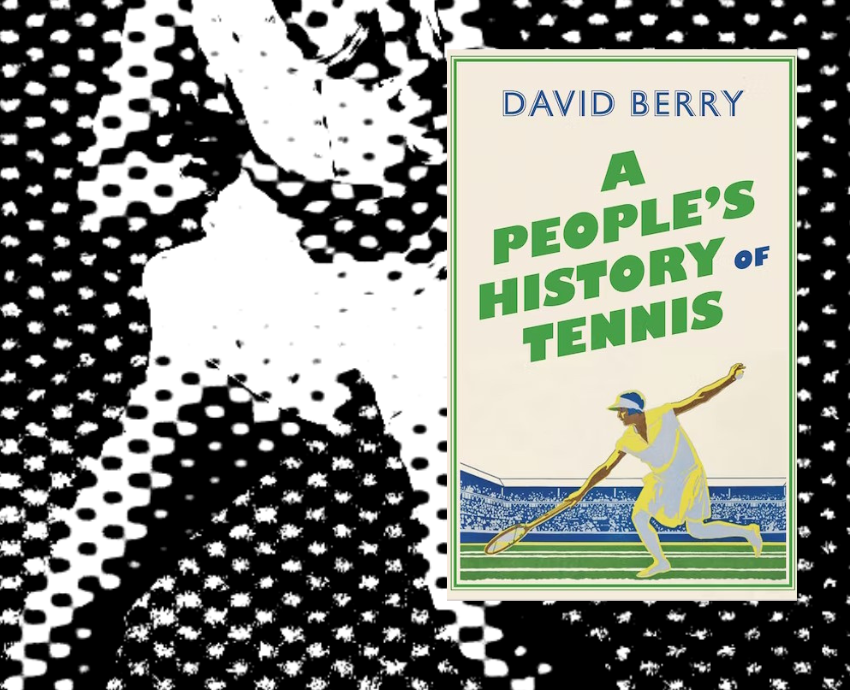
A People’s History of Tennis
By David Berry
London, Pluto Press, 2020
247pp
In 1913, Suffragette activists were thwarted in their attempt to vandalise Wimbledon’s centre court — part of their campaign to force the British government to give women the vote by targeting sporting facilities seen as bastions of male domination.
The reporting of this incident served to reinforce the popular image of tennis as a conservative male-dominated sport. However, in his 2020 book, A People’s History of Tennis, writer, journalist, filmmaker and tennis enthusiast David Berry shows that tennis has a secret radical history.
Berry first took up tennis in 1966, when he and his friends started playing on the public tennis courts in the working-class housing estate in Bracknell, England. Berry reveals that the mother of one of the boys was a local Labour councillor who campaigned for public courts to be built in every part of the town.
The game of lawn tennis was first invented by Major Walter Wingfield in 1874 and the sport became popular almost immediately. The All England Lawn Tennis Club (AELTC) held the first Wimbledon tournament in 1877 and very soon tennis was spreading in popularity throughout Britain and the rest of the world.
Over the first few chapters, Berry tells the stories of tennis stars such as Laurie and Reginald Doherty, Maud Watson, Lottie Dodd, Suzanne Lenglen and Bill Tilden, but also of the players at grassroots level who ensured the sport's survival into the 1920s. We also learn about the underhanded moves by the Slazenger brothers to make sure their company became the suppliers of balls and other tennis equipment to Wimbledon tournaments in the early 1900s.
Tennis, unlike other sports, was designed to be played by both men and women. The first women’s singles tournament at Wimbledon was held in 1884, although it wasn’t until the 1950s that women were allowed to serve on the AELTC committee. Wimbledon would be the last of the Grand Slam tennis tournaments to award women equal prize money, in 2007.
The tennis court served as a site of feminist struggle. However, equality was restricted to the middle classes in the period leading up to World War I, with clubs outright rejecting potential members from working-class backgrounds. Such examples included Osmirk Tennis Club in 1897 and the Kirktonhill club in West Scotland, which maintained it was “open to all”, but in practice, it was only open to people who “fitted in”.
Chapters 5 to 9 cover the 1920s through to the beginning of the Open era in the late 1960s. Berry looks at the various initiatives to make tennis more accessible to working-class people. He starts with the opening of well-maintained public courts in various cities in the 1920s and the formation of the British Workers Sports Federation in 1923, with the involvement of the Communist Party, local Labour party branches and trade unions.
The most important initiative in the working-class sports movements was the National Workers' Tennis Championships, known as “Workers’ Wimbledon”. The tournament was first hosted in 1932, tracing its roots back to various sporting and social club initiatives in the socialist and labour movements from the late 19th century, and would often be attended by trade union officials and Labour MPs. It was avidly followed by the national as well as radical press.
The Workers’ Wimbledon tournaments’ popularity peaked in the 1930s, but after World War II and with the onset of the Cold War, the culture that had enabled the tournament to thrive disappeared. It was last held in 1951, and was largely forgotten , along with the rest of the working-class sporting movements that had thrived in the interwar years.
Meanwhile, up until the late 1960s, the tennis establishment maintained its grip on the game by barring professional players from Wimbledon and the Australian, United States and French championships, forcing them to either go onto the professional circuit or embrace “shamatuerism”, by which players such as Lenglen and Tilden would conceal their money-making while claiming they were amateurs.
It wasn't until 1968 that the ban on professional players in official tennis tournaments ended, beginning the Open era. However, this brought its own problems, with a massive investment of time and resources required to compete at the top level of the sport.
The final chapters of A People’s History of Tennis document the post-1968 era, looking at players such as Althea Gibson, Billie-Jean King, Arthur Ashe, Martina Navratilova, and Venus and Serena Williams, who made crucial gains for feminism, Black players and LGBTIQ communities through their exploits on and off the court.
At the same time, Berry documents the efforts of coaches such as Cas Fish, who, through the creation of the “Dolphin squad” in the late 1960s, tried to create a generation of working-class champions from Britain’s inner cities — especially Black youths. However, due to the lack of resources, the Dolphin Squad was wound up in 1974.
Lack of government resources into tennis and barriers of class and racism meant that in Britain — which the book mainly focuses on — the only Black player in the World Top 50 at the time of writing this book was Heather Watson, who has a millionaire father. Even today, the image of tennis as an elitist sport is hard to shake.
Despite its contradictions, Berry has demonstrated that tennis, like any other sport or recreational activity, should be accessible to everyone and that it can be a sitet of struggle for a better world. Berry also demonstrates the need to remember the history of initiatives such as Workers’ Wimbledon and it is for this reason I recommend A People’s History of Tennis.